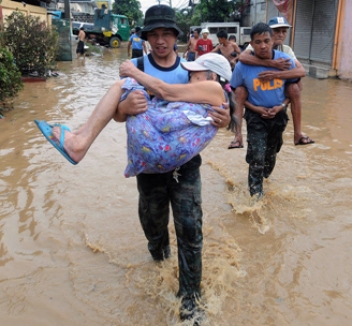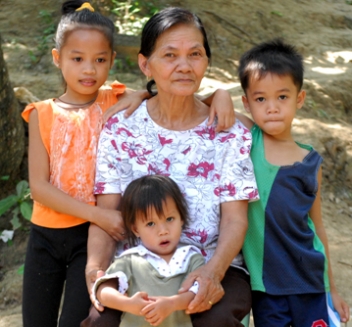 This International Day of Disaster Reduction, I was thinking about the theme of children and young people being partners in disaster risk reduction and how it applies to my own experience working in emergencies with HelpAge.
This International Day of Disaster Reduction, I was thinking about the theme of children and young people being partners in disaster risk reduction and how it applies to my own experience working in emergencies with HelpAge.
Ketsana, known in the Philippines as Ondoy, was one of the most devastating typhoons to hit the country in recent times, causing widespread flooding in September 2009.
The strong winds tore through rural areas and Metro Manila, knocking down trees, electricity poles and advertisement boards. More critically, it destroyed the homes and assets of poor communities, causing untold misery and trauma.
Poor households live in houses built with materials that cannot withstand strong winds. Ketsana blew away these humble dwellings and brought floods that destroyed everything some people had.
Like the end of the world
Houses in poor communities are built close together without any separation. They are like huge houses in which thousands of people live. When they are destroyed by floods or fire, it seems like the end of the world to their occupants. Children, adults and older people are all affected.
I visited some of the flooded areas in Metro Manila and Camirines Norte, including a visit to indigenous people belonging to the Kabihug tribe, who live in the mountains. They told me I was the first foreigner ever to visit them.
There were children eveywhere, making the most of the school holidays and enjoying their free time in the big muddy swimming pool. The adults were running around frantically trying to salvage what they could. The older people rummaged through the debris in search of their meagre possessions; some were searching for ropes to tie down the torn sheets that served as their home and others were caring for their small grandchildren.
Young and old came together
 In the days that followed, people started to regroup mentally, take stock and start rebuilding. The big questions looming in front of them were, “where to begin?” and “how will we ever feel safe again?”. They had to begin somewhere.
In the days that followed, people started to regroup mentally, take stock and start rebuilding. The big questions looming in front of them were, “where to begin?” and “how will we ever feel safe again?”. They had to begin somewhere.
In these situations, children are helpful. For them life does not stop. They keep going and doing the same things at home as they did in the past. Their energy and will to live is a strong motivator for the rest of the family. Children provide others in their family with the desire and energy to look ahead with optimism and start over.
Many children lost their own valued possessions, including their school books during Ketsana. They had to come to terms with this loss and start their recovery. In many cases, I saw older people playing a major role in helping children deal with loss.
Older people helped children overcome feelings of anxiety through stories of how they had coped with similar situations in the past. Older people took care of children who were sick. They gave advice and suggestions to young adults on how to slowly rebuild their lives without losing hope.
Turning tragedy into triumph
In the Kabihug tribe, children didn’t have a school to go to. A project, supported by HelpAge International with funds from Age UK, built a multi-purpose centre with bamboo and thatched leaves, which is now used as a school during the day.
The community also received solar powered lighting for the new venue, which enables evening meetings and audio visual teaching for students during the day. This community, which has been marginalised from the rest of society for most of their lives, converted the Ketsana disaster into an opportunity to better their community and their children’s chance to get an education.
The community also received two buffaloes to help with farming. The children, adults and older people work the fields together. Students learn real life lessons through experiences shared by their parents and grandparents.
Strengthening the bond between generations
HelpAge uses older people’s associations to train communities on how to manage the risk of natural disasters. While the activities are organised by older people’s associations, children also take part. The intergenerational aspect is an important part of disaster risk reduction as it maximises the strong bond between grandparents and grandchildren.
I have seen older people teaching children to put their books in safe places; teaching them to understand monsoon and typhoon patterns using historical information; how to study cloud formations and weather changes that bring heavy rain; the risks for people living by a river, lake, creek or draining outlet; safe places in the house; the shortest route to evacuation centres; and how to wait out a storm or typhoon.
Disaster risk reduction must include everyone; young and old
These are important lessons for children and they will grow up to become future leaders and create safer and more resilient communities. I also observed that the children in the Kabihug tribe have a better knowledge of weather patterns than those in Metro Manila due to their dependence on nature for their lives and livelihood. The transfer of knowledge in the tribal community from the old to the young is a natural process.
On the occasion of the International Day of Disaster Reduction, the message from the field is that intergenerational approaches and inclusive programmes make communities safer, stronger and more resilient.
Children, supported by older people, have a key role in ensuring disaster risk reduction programmes are successful.
Download our disaster risk reduction factsheets and manuals
Find out about the role older people play in emergencies
Read more about International Day of Disaster Reduction
